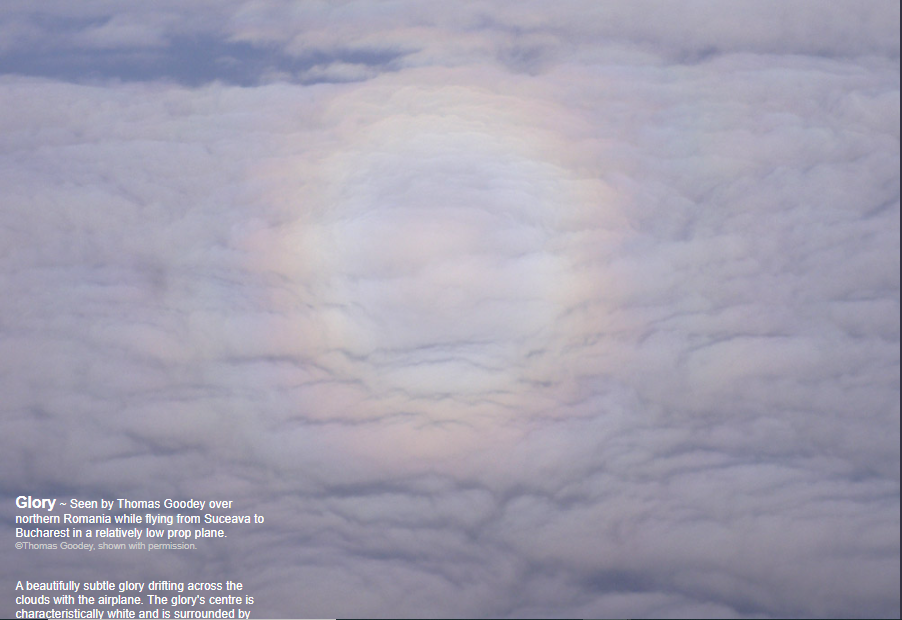OPOD - Glory
OPOD - Glory: A Phenomenon of Subtle Beauty
Glory is a captivating atmospheric optics phenomenon that often goes unnoticed by many. However, for those fortunate enough to witness it, it presents a truly mesmerizing sight. The phenomenon is characterized by a central white spot surrounded by one or more colored rings, creating an ethereal display against the backdrop of the clouds. In this article, we delve deeper into the intricacies of glory and explore its formation and appearance.
Cloud water droplets play a pivotal role in the creation of a glory. When sunlight interacts with these tiny droplets, it undergoes a process called backscattering, where the light is scattered back in the direction it came from. This scattering of light gives rise to the glory's distinctive rings. The number of rings visible in a glory depends on the uniformity of the drop sizes within the clouds. Clouds with a wide distribution of drop sizes result in overlapping glories of different sizes, blurring the rings and giving rise to a soft glow around the center.
To catch a glimpse of a glory, one must observe the clouds on the side of the aircraft opposite to the sun. The glory appears directly opposite the sun and often encircles the shadow cast by the airplane. This positioning provides an optimal viewing angle for observers onboard an aircraft.
While glories can be observed from various vantage points, they are particularly captivating when viewed from an airplane. As the aircraft traverses through the sky, the glory seems to drift alongside it, creating a dynamic and ever-changing spectacle. The interplay between the glory and the clouds adds an extra layer of enchantment to the experience.
It is worth noting that glories are not exclusive to airplanes and can also be observed from other elevated locations, such as mountaintops or tall buildings. However, being airborne offers a unique perspective, allowing for a more immersive encounter with this atmospheric wonder.
The appearance of a glory can vary depending on atmospheric conditions and the observer's position. The rings may exhibit different colors, ranging from vibrant hues to more subdued tones. This diversity in color is influenced by factors such as the size of the water droplets and the angle at which sunlight interacts with them. The interplay of these variables creates a stunning array of colors within the glory.
Glories are not limited to a specific time of day, although they are most commonly observed when the sun is low on the horizon. During these moments, the sunlight travels through a greater thickness of the atmosphere, enhancing the scattering effect and intensifying the glory's appearance.
In conclusion, glories are a captivating atmospheric phenomenon that unveils its subtle beauty to those who cast their gaze upon it. Whether witnessed from an airplane or another elevated location, glories offer a glimpse into the intricacies of light scattering and the enchanting interplay between sunlight, clouds, and water droplets. So, the next time you find yourself airborne or atop a lofty perch, remember to cast your eyes towards the clouds and keep an eye out for the elusive glory.

Glory ~ Seen by Thomas Goodey over northern Romania while flying from Suceava to Bucharest in a relatively low prop plane. ©Thomas Goodey, shown with permission.

A beautifully subtle glory drifting across the clouds with the airplane. The glory's centre is characteristically white and is surrounded by one or more coloured rings. Here there are two.
Cloud water droplets backscatter light to form the glory and the ring number depends on how uniform are the drop sizes. 'Old' clouds with a wide drop size distribution produce overlapping glories of different sizes. The result can be that the rings are blurred out and that is then seen is a soft glow at the location of the glory centre.
To see a glory check the clouds on the side of the aircraft away from the sun. The glory is located directly opposite the sun and often surround the airplane shadow.
Note: this article has been automatically converted from the old site and may not appear as intended. You can find the original article here.
Reference Atmospheric Optics
If you use any of the definitions, information, or data presented on Atmospheric Optics, please copy the link or reference below to properly credit us as the reference source. Thank you!
-
<a href="https://atoptics.co.uk/blog/opod-glory-2/">OPOD - Glory</a>
-
"OPOD - Glory". Atmospheric Optics. Accessed on November 26, 2024. https://atoptics.co.uk/blog/opod-glory-2/.
-
"OPOD - Glory". Atmospheric Optics, https://atoptics.co.uk/blog/opod-glory-2/. Accessed 26 November, 2024
-
OPOD - Glory. Atmospheric Optics. Retrieved from https://atoptics.co.uk/blog/opod-glory-2/.